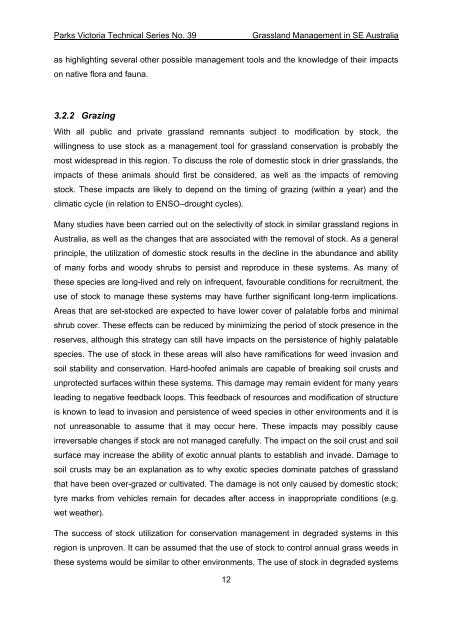Review of Grassland Management in south-eastern ... - Parks Victoria
Review of Grassland Management in south-eastern ... - Parks Victoria
Review of Grassland Management in south-eastern ... - Parks Victoria
Create successful ePaper yourself
Turn your PDF publications into a flip-book with our unique Google optimized e-Paper software.
<strong>Parks</strong> <strong>Victoria</strong> Technical Series No. 39<br />
<strong>Grassland</strong> <strong>Management</strong> <strong>in</strong> SE Australia<br />
as highlight<strong>in</strong>g several other possible management tools and the knowledge <strong>of</strong> their impacts<br />
on native flora and fauna.<br />
3.2.2 Graz<strong>in</strong>g<br />
With all public and private grassland remnants subject to modification by stock, the<br />
will<strong>in</strong>gness to use stock as a management tool for grassland conservation is probably the<br />
most widespread <strong>in</strong> this region. To discuss the role <strong>of</strong> domestic stock <strong>in</strong> drier grasslands, the<br />
impacts <strong>of</strong> these animals should first be considered, as well as the impacts <strong>of</strong> remov<strong>in</strong>g<br />
stock. These impacts are likely to depend on the tim<strong>in</strong>g <strong>of</strong> graz<strong>in</strong>g (with<strong>in</strong> a year) and the<br />
climatic cycle (<strong>in</strong> relation to ENSO–drought cycles).<br />
Many studies have been carried out on the selectivity <strong>of</strong> stock <strong>in</strong> similar grassland regions <strong>in</strong><br />
Australia, as well as the changes that are associated with the removal <strong>of</strong> stock. As a general<br />
pr<strong>in</strong>ciple, the utilization <strong>of</strong> domestic stock results <strong>in</strong> the decl<strong>in</strong>e <strong>in</strong> the abundance and ability<br />
<strong>of</strong> many forbs and woody shrubs to persist and reproduce <strong>in</strong> these systems. As many <strong>of</strong><br />
these species are long-lived and rely on <strong>in</strong>frequent, favourable conditions for recruitment, the<br />
use <strong>of</strong> stock to manage these systems may have further significant long-term implications.<br />
Areas that are set-stocked are expected to have lower cover <strong>of</strong> palatable forbs and m<strong>in</strong>imal<br />
shrub cover. These effects can be reduced by m<strong>in</strong>imiz<strong>in</strong>g the period <strong>of</strong> stock presence <strong>in</strong> the<br />
reserves, although this strategy can still have impacts on the persistence <strong>of</strong> highly palatable<br />
species. The use <strong>of</strong> stock <strong>in</strong> these areas will also have ramifications for weed <strong>in</strong>vasion and<br />
soil stability and conservation. Hard-ho<strong>of</strong>ed animals are capable <strong>of</strong> break<strong>in</strong>g soil crusts and<br />
unprotected surfaces with<strong>in</strong> these systems. This damage may rema<strong>in</strong> evident for many years<br />
lead<strong>in</strong>g to negative feedback loops. This feedback <strong>of</strong> resources and modification <strong>of</strong> structure<br />
is known to lead to <strong>in</strong>vasion and persistence <strong>of</strong> weed species <strong>in</strong> other environments and it is<br />
not unreasonable to assume that it may occur here. These impacts may possibly cause<br />
irreversable changes if stock are not managed carefully. The impact on the soil crust and soil<br />
surface may <strong>in</strong>crease the ability <strong>of</strong> exotic annual plants to establish and <strong>in</strong>vade. Damage to<br />
soil crusts may be an explanation as to why exotic species dom<strong>in</strong>ate patches <strong>of</strong> grassland<br />
that have been over-grazed or cultivated. The damage is not only caused by domestic stock;<br />
tyre marks from vehicles rema<strong>in</strong> for decades after access <strong>in</strong> <strong>in</strong>appropriate conditions (e.g.<br />
wet weather).<br />
The success <strong>of</strong> stock utilization for conservation management <strong>in</strong> degraded systems <strong>in</strong> this<br />
region is unproven. It can be assumed that the use <strong>of</strong> stock to control annual grass weeds <strong>in</strong><br />
these systems would be similar to other environments. The use <strong>of</strong> stock <strong>in</strong> degraded systems<br />
12

















